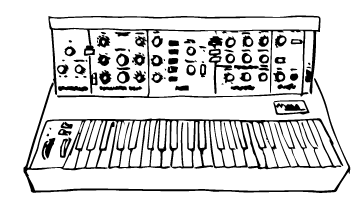Moog Minimoog
Introduction
Date: 1970
Type: Monophonic / Subtractive / Analogue
One of the most famous & iconic synths ever made, the Minimoog was the first keyboard based portable synthesizer and was immediately successful at launch. Over 14,000 were made between 1970 and 1980, with the Moog company moving locations from Trumansburg to Williamsville over the duration and changing hands several times.
The instrument was immediately popular at launch with keyboard players of all genres – rock, prog, jazz, and the burgeoning electronic styles – as a more affordable and easier to use version of the preceding modular synthesizers, and introduced the now standard ‘pitch wheel’. The list of verified tracks using the Minimoog is likely to extend to 1,000s long – and that’ll just be the well known songs!
Apart from its powerful three oscillator sound and over-driven filter circuits, one of the keys to its success was the inclusion of a built in keyboard, something not previously seen on portable self-contained synthesizers, such as the EMS VCS 3 (1969). This enabled it to be taken up by electric organ and electric piano players with ease…and it was.
Archetypal Track
Parliament, ‘Flashlight’ (1976) Bassline
Bernie Worrell claims to have used four Minimoogs to create this fatter than fat bassline. Here he is playing that bassline in 2016 (Still got it!):
10 minutes with Bernie Worrell
First Ever Minimoog Track
Mother Mallard's portable Masterpiece Company, 'Easter' (1970)
David Borden was an in house musician at Moog’s HQ and had early access to the Minimoog. The original performance of this piece on Easter Sunday, 1970, made use of it – though the occasion was not recorded. Electronic Sound Magazine, Nov 2021
Associated artists
There are many artists closely associated with the Minimoog, here are some of those notable musicians.
Gary Numan
“I looked to what they (Kraftwerk) were doing. A shining light to how music could be put together, completely different…When I found the Minimoog and pressed the key, the whole room shook with the power of it, I thought ‘that’s it, that’s exactly what I’m after’.
Dr Dre
“At the same time [Dre and I] were like, ‘We need to do some P-Funk-sounding shit.’ We wanted to make a real Parliament-Funkadelic album.,” Wolfe said in a 2014 interview with Wax Poetics magazine. “Take “Fuck wit Dre Day,” for instance. I was thinking of Bernie Worrell when I was doing those kind of sounds. And that’s why the Moog is so predominant on The Chronic.”
Jan Hammer
Jan Hammer was famed for his virtuosic Minimoog performances. Here he is in his pomp with Mahavishnu Orchestra in 1973
Table of all ARP Odyssey Tracks
Notable tracks are highlighted rows
| Artist | Track | Year | Song Part | Notes & Reference | Media |
| ARP Analog Synth Jazz Band | Take The A Train | 1980 | ‘Tap Dancer Getting Shot’ | A TV spot featuring nine ARP synths, introduced by one a presenter in that ‘incredulous’ style, like they’ve never seen a piece of technology before. arpysynth.com |
YouTube |
| Chick Corea | Space Circus | 1974 | Solos | Trading licks with Bill Connors. | YouTube |
| Deep Purple | Space Truckin’ (Live) | 1974 | Solo | Jon Lord lets rip on the Odyssey during this 15 minute classic Deep Purple jam. YouTube |
YouTube |
| Frank Zappa | Inca Roads | 1974 | LFO Synth Effects | This song appears on the album “One Size Fits All.” In the intro, George Duke uses an Odyssey Rev1 to create an LFO based sound effect. arpsynth.com |
YouTube |
| Gary Numan | Cars | 1979 | Synth Lead | "I still like to use the ARP Odyssey because it has the best window-shaking bottom end of any synth." - Gary Numan | YouTube |
| George Duke | Funny Funk | 1974< | Bass/Synth Lead | Album: Feel ”He (Frank Zappa) told me one day, that I should play synthesizers. It was as simple as that! I finally settled on ... an ARP Odyssey. I decided to use an ARP, purely to be different from Jan Hammer, who was playing the Mini Moog, and had a head start on me in the mastery of synthesis. I was really drawn to the possibilities inherent therein. There were some things that were a drag also! Remember, at this time there were no presets or ways of saving patches. Not only that, but you were limited to one note at a time. So overdubbing, a good memory and management system became very important. The year was 1974.” |
YT |
